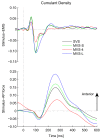Electrical vestibular stimuli to enhance vestibulo-motor output and improve subject comfort
- PMID: 24392130
- PMCID: PMC3879299
- DOI: 10.1371/journal.pone.0084385
Electrical vestibular stimuli to enhance vestibulo-motor output and improve subject comfort
Abstract
Electrical vestibular stimulation is often used to assess vestibulo-motor and postural responses in both clinical and research settings. Stochastic vestibular stimulation (SVS) is a recently established technique with many advantages over its square-wave counterpart; however, the evoked muscle responses remain relatively small. Although the vestibular-evoked responses can be enhanced by increasing the stimulus amplitude, subjects often perceive these higher intensity electrical stimuli as noxious or painful. Here, we developed multisine vestibular stimulation (MVS) signals that include precise frequency contributions to increase signal-to-noise ratios (SNR) of stimulus-evoked muscle and motor responses. Subjects were exposed to three different MVS stimuli to establish that: 1) MVS signals evoke equivalent vestibulo-motor responses compared to SVS while improving subject comfort and reducing experimentation time, 2) stimulus-evoked vestibulo-motor responses are reliably estimated as a linear system and 3) specific components of the cumulant density time domain vestibulo-motor responses can be targeted by controlling the frequency content of the input stimulus. Our results revealed that in comparison to SVS, MVS signals increased the SNR 3-6 times, reduced the minimum experimentation time by 85% and improved subjective measures of comfort by 20-80%. Vestibulo-motor responses measured using both EMG and force were not substantially affected by nonlinear distortions. In addition, by limiting the contribution of high frequencies within the MVS input stimulus, the magnitude of the medium latency time domain motor output response was increased by 58%. These results demonstrate that MVS stimuli can be designed to target and enhance vestibulo-motor output responses while simultaneously improving subject comfort, which should prove beneficial for both research and clinical applications.
Conflict of interest statement
Figures





References
-
- Nashner LM, Wolfson P (1974) Influence of head position and proprioceptive cues on short latency postural reflexes evoked by galvanic stimulation of human labyrinth. Brain Research 67: 255–268. - PubMed
-
- Britton TC, Day BL, Brown P, Rothwell JC, Thompson PD, et al. (1993) Postural electromyographic responses in the arm and leg following galvanic vestibular stimulation in man. Experimental Brain Research 94: 143–151. - PubMed
-
- Fitzpatrick R, Burke D, Gandevia SC (1996) Loop gain of reflexes controlling human standing measured with the use of postural and vestibular disturbances. Journal of Neurophysiology 76: 3994–4008. - PubMed
-
- Iles JF, Baderin R, Tanner R, Simon A (2007) Human standing and walking: comparison of the effects of stimulation of the vestibular system. Experimental Brain Research 178: 151–166. - PubMed
-
- Goldberg JM, Smith CE, Fernandez C (1984) Relation between discharge regularity and responses to externally applied galvanic currents in vestibular nerve afferents of the squirrel-monkey. Journal of Neurophysiology 51: 1236–1256. - PubMed
Publication types
MeSH terms
Grants and funding
LinkOut - more resources
Full Text Sources
Other Literature Sources

